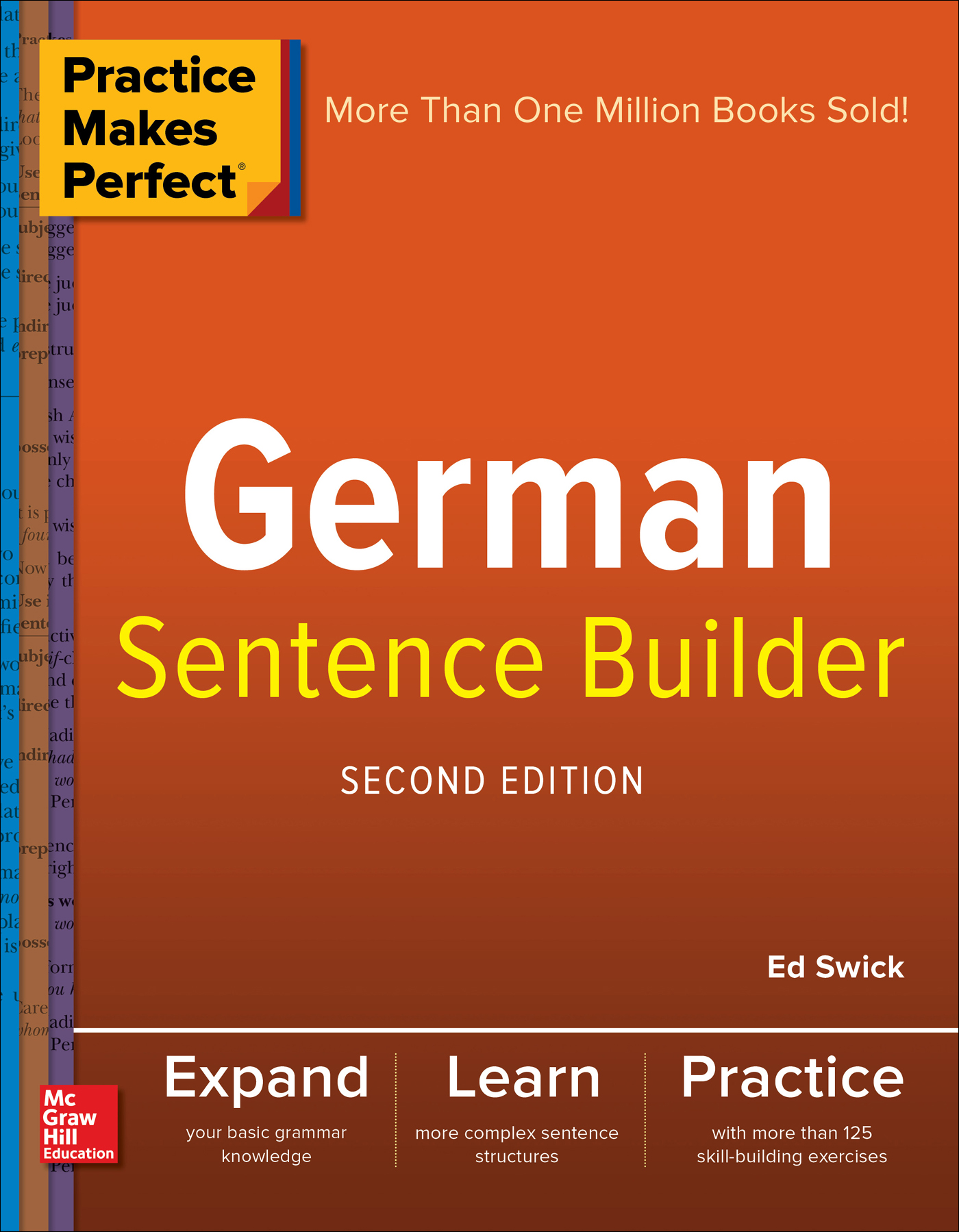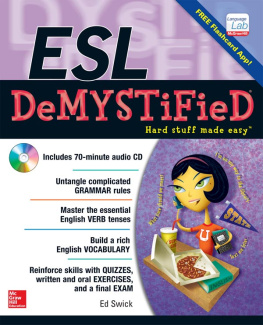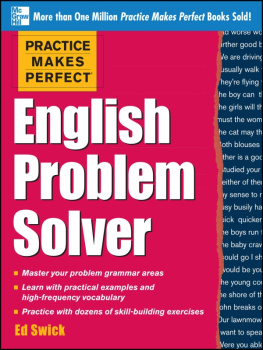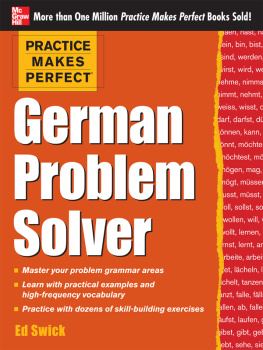Ed Swick - Practice Makes Perfect German Sentence Builder
Here you can read online Ed Swick - Practice Makes Perfect German Sentence Builder full text of the book (entire story) in english for free. Download pdf and epub, get meaning, cover and reviews about this ebook. year: 2018, publisher: McGraw-Hill Education, genre: Children. Description of the work, (preface) as well as reviews are available. Best literature library LitArk.com created for fans of good reading and offers a wide selection of genres:
Romance novel
Science fiction
Adventure
Detective
Science
History
Home and family
Prose
Art
Politics
Computer
Non-fiction
Religion
Business
Children
Humor
Choose a favorite category and find really read worthwhile books. Enjoy immersion in the world of imagination, feel the emotions of the characters or learn something new for yourself, make an fascinating discovery.

Practice Makes Perfect German Sentence Builder: summary, description and annotation
We offer to read an annotation, description, summary or preface (depends on what the author of the book "Practice Makes Perfect German Sentence Builder" wrote himself). If you haven't found the necessary information about the book — write in the comments, we will try to find it.
Practice Makes Perfect German Sentence Builder — read online for free the complete book (whole text) full work
Below is the text of the book, divided by pages. System saving the place of the last page read, allows you to conveniently read the book "Practice Makes Perfect German Sentence Builder" online for free, without having to search again every time where you left off. Put a bookmark, and you can go to the page where you finished reading at any time.
Font size:
Interval:
Bookmark:

 Copyright 2018 by McGraw-Hill Education. All rights reserved. Except as permitted under the United States Copyright Act of 1976, no part of this publication may be reproduced or distributed in any form or by any means, or stored in a data base or retrieval system, without the prior written permission of the publisher. ISBN: 978-1-26-001913-1
Copyright 2018 by McGraw-Hill Education. All rights reserved. Except as permitted under the United States Copyright Act of 1976, no part of this publication may be reproduced or distributed in any form or by any means, or stored in a data base or retrieval system, without the prior written permission of the publisher. ISBN: 978-1-26-001913-1MHID: 1-26-001913-6 The material in this eBook also appears in the print version of this title: ISBN: 978-1-26-001912-4, MHID: 1-26-001912-8. eBook conversion by codeMantra
Version 1.0 All trademarks are trademarks of their respective owners. Rather than put a trademark symbol after every occurrence of a trademarked name, we use names in an editorial fashion only, and to the benefit of the trademark owner, with no intention of infringement of the trademark.
Where such designations appear in this book, they have been printed with initial caps. McGraw-Hill Education eBooks are available at special quantity discounts to use as premiums and sales promotions or for use in corporate training programs. To contact a representative, please visit the Contact Us page at www.mhprofessional.com. Trademarks: McGraw-Hill Education, the McGraw-Hill Education logo, Practice Makes Perfect, and related trade dress are trademarks or registered trademarks of McGraw-Hill Education and/or its affiliates in the United States and other countries and may not be used without written permission. All other trademarks are the property of their respective owners. McGraw-Hill Education is not associated with any product or vendor mentioned in this book.
TERMS OF USE This is a copyrighted work and McGraw-Hill Education and its licensors reserve all rights in and to the work. Use of this work is subject to these terms. Except as permitted under the Copyright Act of 1976 and the right to store and retrieve one copy of the work, you may not decompile, disassemble, reverse engineer, reproduce, modify, create derivative works based upon, transmit, distribute, disseminate, sell, publish or sublicense the work or any part of it without McGraw-Hill Educations prior consent. You may use the work for your own noncommercial and personal use; any other use of the work is strictly prohibited. Your right to use the work may be terminated if you fail to comply with these terms. THE WORK IS PROVIDED AS IS.
McGRAW-HILL EDUCATION AND ITS LICENSORS MAKE NO GUARANTEES OR WARRANTIES AS TO THE ACCURACY, ADEQUACY OR COMPLETENESS OF OR RESULTS TO BE OBTAINED FROM USING THE WORK, INCLUDING ANY INFORMATION THAT CAN BE ACCESSED THROUGH THE WORK VIA HYPERLINK OR OTHERWISE, AND EXPRESSLY DISCLAIM ANY WARRANTY, EXPRESS OR IMPLIED, INCLUDING BUT NOT LIMITED TO IMPLIED WARRANTIES OF MERCHANTABILITY OR FITNESS FOR A PARTICULAR PURPOSE. McGraw-Hill Education and its licensors do not warrant or guarantee that the functions contained in the work will meet your requirements or that its operation will be uninterrupted or error free. Neither McGraw-Hill Education nor its licensors shall be liable to you or anyone else for any inaccuracy, error or omission, regardless of cause, in the work or for any damages resulting therefrom. McGraw-Hill Education has no responsibility for the content of any information accessed through the work. Under no circumstances shall McGraw-Hill Education and/or its licensors be liable for any indirect, incidental, special, punitive, consequential or similar damages that result from the use of or inability to use the work, even if any of them has been advised of the possibility of such damages. To Riane, AJ, Jalyn, and Riley, my terrific grandkids.
This is particularly true in a foreign language. The goal of this book is to guide you through the various types of structures in the German language and to illustrate how those structures combine to make sentences. Naturally, in order to acquire writing skills you have to write. Therefore, you will be provided with an abundance of writing exercises. Some will require a small variation in a given sentence. Others will provide you with a series of words that you form into an appropriate sentence.
And you will have plenty of opportunity for coming up with original sentences of your own. This development of your German sentence writing moves gradually and with careful explanation from the least complex activity to the most complex.  In addition to the illustrations of how structures combine to form sentences and the practice exercises, an answer key is provided at the end of the book. It includes not only the correct answers for the exercises but also sample sentences for you to compare to your original sentences. Good sentence writing is not an impossible task. But it requires analysis, practice, and a willingness to apply concepts and rules consistently.
In addition to the illustrations of how structures combine to form sentences and the practice exercises, an answer key is provided at the end of the book. It includes not only the correct answers for the exercises but also sample sentences for you to compare to your original sentences. Good sentence writing is not an impossible task. But it requires analysis, practice, and a willingness to apply concepts and rules consistently.
Let this book guide you, and you will discover a new confidence as you write more successfully in German. Viel Glck!
 Declarative sentences and word order
Declarative sentences and word orderKarl + singt + gut.
Karl sings well. In the example above, the subject is Karl and the verb singt is conjugated in the present tense for the third person singular subject. This basic structure is used in great abundance in the language and can be modified in a variety of ways. Nonetheless, its simple formula is subject plus predicate.
If one of those elements is missing, you dont have a sentence.  And still others can be written in the passive voice:
And still others can be written in the passive voice:  In other words, a declarative sentence can take many forms. Lets look at a series of sentences composed in this way. Take note of the subjects, the variety of verb types in the predicate, and the various tenses that can be used in declarative sentences. Many sentences are composed of a present perfect tense verb and the auxiliary haben:
In other words, a declarative sentence can take many forms. Lets look at a series of sentences composed in this way. Take note of the subjects, the variety of verb types in the predicate, and the various tenses that can be used in declarative sentences. Many sentences are composed of a present perfect tense verb and the auxiliary haben:  Remember that the present perfect tense is the more common form to use to describe an action in the past. The German simple past tense is used more often in a narrative.
Remember that the present perfect tense is the more common form to use to describe an action in the past. The German simple past tense is used more often in a narrative.
But both forms can be translated into English in the same way. 
Font size:
Interval:
Bookmark:
Similar books «Practice Makes Perfect German Sentence Builder»
Look at similar books to Practice Makes Perfect German Sentence Builder. We have selected literature similar in name and meaning in the hope of providing readers with more options to find new, interesting, not yet read works.
Discussion, reviews of the book Practice Makes Perfect German Sentence Builder and just readers' own opinions. Leave your comments, write what you think about the work, its meaning or the main characters. Specify what exactly you liked and what you didn't like, and why you think so.




